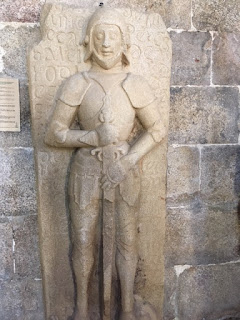We were quite happy, therefore, to find an option that would add about 5km to see something special. Just north of hamlet Portos, we took a small country lane to the right and followed it until we came to Vilar des Donas, after being assured at the cafe in Portos it was open.
It was not open, but after trying the door a few times and resigning ourselves to the disappointment, a sprightly 90 year old man came out of nowhere and asked if we'd like to see inside.
What makes this small country church so special includes its age. It was originally a family monastery (not uncommon in Galicia), for nuns, hence the name Villar des Donas, as Donas means ladies. It was given to the Order of Santiago in 1184. Castilian royalty visited it and gave donations, and it remained as such until the 19th century when it was reduced in importance to become a parish church.
Okay, so it is old. But it is also incredibly unusual in that the decoration incorporates Celtic motifs, German/Visigoth elements, Moorish elements, Romanesque Christian elements, all together in one happy place. Can you imagine a religious house that accommodates and celebrated so many faiths and variations of faiths so generously?
 |
| Exterior facade with Visigothic floral, Celtic thistle, Moorish zigzag, Greek acanthus leaves among other elements |
the capitals by the door at still extremely easy to decipher
The doors are "only" 400 years old, but the metalwork is 12th century and expertly done, right down to the hand-forged nails and hinges
Inside the doors, there are several steps down to the floor, which is unusual, and one can see the original cross above the top of the doors.
There were no windows originally - these were added to let in light but were really well thought out to let in light to specific places. For example, one alcove near the altar holds a statue, but the other is plain, with an angled base. This is so the bible could be read with the light from the window opposite.
As in most ancient churches, built before the church-goers could read, the stones were meant to "speak" and tell stories to those that attended mass.
 |
| the waves of the sea between the Celtic lands and Galicia |
 |
| an allegory showing geese (on the left) eating a serpent and a serpent (on the right) eating a goose |
 |
| the tree of life/knowledge with seven branches, the doors of which lead to hell |
 |
| the water on the right, the earth on the left, and what is meant to be a shamrock, which has three leaves on one stem, signifying the Father, the Son and the Holy Ghost as one |
There are crests carved on the graves indicating the most wealthy and powerful knights and families in the whole of Galicia were associated with this place: the Amarante, Ulloa, Varela, Seixas, Gayoso, and Pineiro, many of whom have/had manor houses (pazos) along the Camino.
But the best, the best thing of all are the frescoes. They have not been touched and retain their gorgeous colours, primarily because they were covered with whitewash when a Baroque altarpiece was installed. This was recently removed, as was the whitewash,to reveal these frescoes.
 |
| an usual pregnant Mary |
 |
| cross of St. James and scallop shells |
 |
| an particularly expressive Christ |
Unusually, Castillian monarchs are the time were also depicted, including John II of Castile, the father of the famous Isabel who, with her husband Ferdinand, united Spain, and supported Christopher Columbus on his voyages. She also initiated the Spanish Inquisition, so she is infamous as well!
 We learned so much and were lucky to see it when the sun was hitting it at the right time. what a treat!
We learned so much and were lucky to see it when the sun was hitting it at the right time. what a treat! |
| Left |
 |
| Right |
 |
| and the Grail in the middle |
















Wow!
ReplyDelete